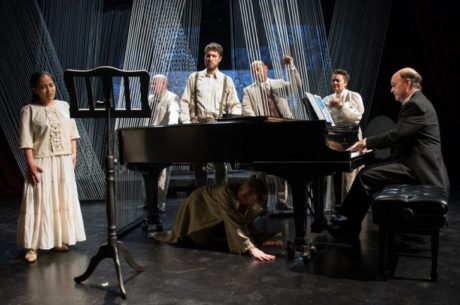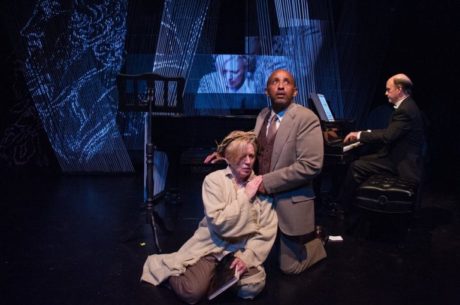Theater can be many things: challenging, and then restoring; transcendent, and yet—fundamental. A platform for the cutting-edge and a welcoming home-fire for the familiar.

Rarely does a single show encompass all of these elements—but they are in the In Series’ DNA. The company’s latest production, Viva V.E.R.D.I. – The Promised End, under the intellectually curious and boundlessly exploratory leadership of its new Artistic Director, Timothy Nelson, is energetically and synergistically realized here by the show’s Director, Steven Scott Mazzola. It is a masterly, one-of-a-kind production written by Nelson that deftly weaves several of its musical, textual and literary strands into new configurations that could well leave you wondering if you will ever be able to see the production’s two principal components—Giuseppe Verdi’s Messa da Requiem and Shakespeare’s King Lear—the same way again.
The . . . mass? play? opera? opens with Nanna Ingvarsson, in the sole speaking role, in a thigh-length burgundy one-button jacket, accented with a grey-checked vest and billowing dark grey tie (Costume Designer: Maria Bisset), recalling “his” (i.e., Verdi’s) funeral, which brings to his mind those, decades earlier, of his young children—which had, in a cruel irony, bracketed the successful premieres of two of his operas. As if to show that Fate hadn’t finished with him, they were followed shortly thereafter, he tells us bitterly, by the death of his wife.
As Verdi speaks, from an offstage chorus (the six soloists) come the strains of “Va, pensiero,” the iconic “Chorus of the Hebrew Slaves” from one of those operas, Nabucco, and he brightens, telling us that he in fact “gave birth to twenty-seven children”—his operas. “And there should have been a twenty-eighth,” he observes. “Lear‘s shadow, always with me.”
The set, by Jonathan Dahm Robertson, is simple but hallucinatory: A single step separates its two levels, the higher one dominated by groups of slender, undulating, floor-to-ceiling diagonal cords. A vertical video screen flashing assorted evocative images stretches across the back of the stage. The lighting, by Lighting Designer Marianne Meadows, is many-layered, following and illuminating the narrative arc with full or striated white and yellow light and shadow ranging from dark to dusky.
Conducting from the piano, elegantly attired in black bowtie and tux, Music Director Paul Leavitt accompanied and guided the singers masterfully, drawing out and shaping the singers’ execution of the Requiem’s dramatic and musical contours with deliberate, even theatrical hand gestures that brought to mind the storied music directors of Verdi’s own time.
Nanna Ingvarsson, who switches sometimes on a dime amongst the characters, from Verdi to Shakespeare to Lear, narrates the production from start to finish, in her hands a script book that serves as both prop and prep. While her spoken words will compete at times with the singers’ volume, the ferocity of her portrayals, anchored by an emotional astuteness, will more than hold its own.
Verdi’s Requiem is the musical through line that at once anchors, amplifies and actualizes the show’s narrative, whose Lear-based characters evince mutable moods that sometimes run counter to what we think we know about them, but which Mazzola and his cast, by all evidence, have learned to understand (and to portray) not just dramatically, but intuitively. In the opening “Kyrie” the seven singers—Tenor Brian Arreola, Tenor Peter Burroughs, Mezzo Anamer Castrello, Soprano Natalie Conte, Soprano Teresa Ferrara, Bass Bryan Jackson and Mezzo Elizabeth Mondragon—some dressed in vibrantly colored, almost music-hall-genre attire, step down onto the audience level and join hands, emoting operatically and smiling broadly.

Two of them approach Ingvarsson, now a ranting Lear, each touching one of her shoulders in a gesture of comfort that instead elicits a snarl of rage (from Act II, Scene 4): “No, you unnatural hags!” Turning his wrath upon Leavitt at the piano, Lear calls him his fool, then asserts with increasing intensity and volume, “I would not be mad” (Act I, Scene 5). Ingvarsson’s intensity and agitated demeanor leave the probability of that vow’s attainment an open question.
This sets the stage for the thundering “Dies irae” that interrupts Lear’s tirade as both apt contradiction and suasive illustration; and that, surprisingly, does not suffer appreciably from the lack of an orchestra. The shiver-inducing impact of Verdi’s shrieking winds, strings, percussion, and brass is conveyed quite capably by Leavitt at the keyboard and a single timpani player several feet away, as the four women singers enter the stage, their voices exploding in a terrifying, electrifying cascade of sound. As it diminishes, the women, now dressed in classically individualized white cotton gowns (with or without ruffled bodice), bring more soothing tones.
The “Mors” (Death) in “Mors stupebit,” sung in English by Bass John T.K. Scherch, his sound sepulchral and frightening, was followed by a dramatic and nuanced “Liber scriptus” by Castrello, who closed in on Ingvarsson’s character silently, and with a dark, menacing fury, concluding: “Nil in ultum remanebit” (Nothing shall remain unavenged). As the furious opening runs of the “Dies irae” again burst forth from Leavitt’s nimbly fingered orchestra-piano, the other five singers gather tightly around Ingvarsson (Lear? Shakespeare? Verdi? Any or all?), bending over her and scream-singing (but in perfect pitch), “Dies irae, Dies illa.”
The vocal control and exquisite refinement of Ferrara’s clear lyric soprano shone in the brief “Quid sum miser,” as did that of Conte’s rich, glowing dramatic soprano in the “Recordare” and Conte’s and Ferrara’s gorgeous duet, sung from opposite ends of the small theater to create a sort of divine convergence. Tenor Burroughs excelled in the “Ingemisco,” as did Bass Jackson in the “Confutatis,” each singer seeming to relish the interpretive and range demands of their respective sections.
In the next iteration of the “Dies irae,” the singers again run to Ingvarsson, ready to confront the character; but he is ready for them. Rather than rage, he quietly commands, and they kneel before him.
Equally commanding is Jackson’s ringing, emotional voice in the “Lacrymosa” quartet, strikingly complemented by Ferrara’s ethereal soprano (and indeed, by all three voices). Ingvarsson, now a mournful Kent, says: “Break, heart; I prithee, break!”
That may be the end of Lear (and, more or less, of Lear); but it is not, by far, the end of Viva V.E.R.D.I – The Promised End. The two creative works, till now in a sort of rough partnership, now do visual and auditory battle, the singers’ peaceful, angelic offstage voices pitted against Ingvarsson’s . . . Shakespeare? suddenly violently combative and declamatory, her arms wildly flailing at and laying waste to papers and objects, accompanied by a torrent of angry words that are all but indistinguishable, until the last, a roar of anguish: “Away! And let me die.” It is—not Shakespeare, not even Lear, but Lear’s blinded, anguished Gloucester (Act IV, Scene 6).
The sometimes dizzyingly dichotomous moods of this production come into sharp relief as the singers re-emerge and begin to pass along, with grave solemnity, a crown of wheat. When it reaches Jackson, he puts it on his head, signaling a move to the joyful and triumphant “Sanctus,” which, like a light switch, swiftly turns our protagonist’s mood from “let me die” to Let’s get it on. Ingvarsson’s maniacally bright-eyed, toothy smile is accompanied by a trumpet of the tongue, her “Ta . . . ta-ta-ta-ta’s” in tune with Leavitt’s apparently (and convincingly) reconfigured trumpet-piano. (As she swung away, smile intact, and swayed her way offstage, I almost expected her to say: “That’s all, folks!”)

As the Requiem moved into the “Agnus Dei,” the ambiance changed again, Ferrara’s “Dona eis requiem” a skillfully projected, crystalline near-whisper. The “Lux aeterna” trio that followed was deeply moving, as Mondragon, her rich voice filled with embracing warmth, looked with such heartrending tenderness into Arreola’s eyes, as he returned her gaze and matched her molten vocals in an almost Wagnerian, Tristan-and-Isolde moment, it almost brought tears to my eyes.
The tears would indeed come after, as this remarkable endeavor, this truly groundbreaking musical, textual and literary interfusion came to an end.
Introducing the work at Sunday’s matinee performance, Artistic Director Timothy Nelson noted that Verdi was “obsessed” with Shakespeare’s King Lear and with its unsparing portrayal of the ravages of old age. One of the composer’s “greatest legacies,” he added, is the Casa die Riposo per Musicisti, or House of Rest for (Retired) Musicians. (The home is featured in a fascinating 2008 Italian documentary, Casa Verdi).
“When Verdi’s last name became lionized as an acronymic rallying cry for the nascent nation of Italy,” the program notes tell us—that is, Viva Vittorio Emanuele Re d’Italia, or Long Live Victor Emanuel, King of Italy—”it was historical fact making manifest the idea that art can [serve] as a catalyst for social change.” In its deeply affecting entwining of two venerated masterpieces representing two divergent artistic disciplines, the In Series continues to serve as a catalyst for artistic expression, exploration, and outreach in the D.C. area, and—for those so moved, inspired or inclined—to promote positive, dynamic change throughout the social fabric of, and touched by, the theatergoing community.
Running Time: 90 minutes, with no intermission.
Viva V.E.R.D.I. – The Promised End plays through Sunday, September 23, 2018, at CulturalDC Source Theatre, 1835 14th Street NW, Washington, DC 20009. For tickets, call (202) 204-7760 or purchase them online.




